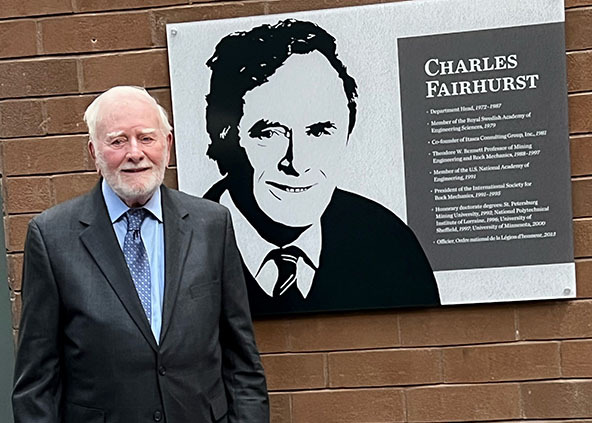Charles Fairhurst Rotunda Dedication
On August 26, family, friends, University of Minnesota staff and students, and Itascans gathered to celebrate the dedication of Room 207CC in the Civil Engineering Building at the University of Minnesota as the Charles Fairhurst Rotunda to honor Professor Emeritus, Charles Fairhurst. Dr. Fairhurst was instrumental in the establishment of the Civil Engineering building, which was built seven floors deep as a demonstration of being able to work and live underground while reducing environmental and energy impacts.

Relocating from the United Kingdom, Fairhurst became a full professor at the University of Minnesota in 1965 and was the Head of the School of Mineral and Metallurgical Engineering for two years, which then became the Department of Civil and Mineral Engineering, where he was Department Head from 1972 to 1987. Dr. Fairhurst has received numerous awards over his career, including:
- Member of the Royal Swedish Academy of Engineering Sciences (1979)
- Member of the U.S. National Academy of Engineering (1991)
- President of the International Society for Rock Mechanics (1991-1995)
- Officer, Order National de la Legion d’honneur (2013)
- Honorary doctorates from the United States, the United Kingdom, Russia, and France
In the 1960s and 1970s, Professor Fairhurst was a driving force behind the establishment of rock mechanics as a recognized engineering discipline. Established in 1962, he was one of the founders of the International Society for Rock Mechanics (ISRM) where he served as president from 1991 until 1995. In 1981, Dr. Fairhurst co-founded Itasca, with many alumni from the University of Minnesota as Itasca’s first consultants.
Through the leadership of Charles Fairhurst, the University of Minnesota became one of the leading research centers in rock mechanics worldwide and the birthplace of several important innovations that have revolutionized the field of rock mechanics, including hydraulic fracturing as a technique for measuring stresses at great depth, determination of the post-peak failure response of rocks using servo-controlled testing machines, computer methods to predict the stability of deep mines, and the distinct element method to model the behavior of blocky rock masses.
His work over decades spans nearly all aspects of rock mechanics and rock engineering: drilling, laboratory testing, mechanical excavation, comminution, stress measurement, stability of underground openings, design of tunnel supports, rock reinforcement, and underground storage of radioactive waste. In more than 150 publications, he consistently emphasized the need for rigorous application of the principles of mechanics to rock engineering.
He was an advisor and mentor to 24 Ph.D. and 27 M.Sc. students and instilled in them all an appreciation for innovative research. These former graduate students, many of whom hold faculty positions in the U.S. and abroad, are known collectively in the rock mechanics community as the “Minnesota Mafia,” with Charles Fairhurst as its godfather.
His former students, friends, and colleagues appreciate the role he has played in their lives and for the important contributions he has made in the field of rock mechanics during his distinguished career.
The above text is based, in large part, from the Introduction in the program for the Fairhurst Colloquium, October 15-16, 2004, Department of Civil Engineering at the University of Minnesota, with updates.
